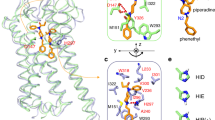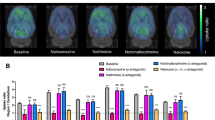Abstract
A principle of opioid pharmacotherapy is that high medication doses should occupy fractionally more opioid receptors that mediate heroin effects. In this preliminary study we examined in vivo μ opioid receptor (μOR) binding in three healthy opioid-dependent volunteers during maintenance on 2 and 16 mg sublingual buprenorphine (BUP) liquid, and after detoxification (0 mg) under double-blind, placebo-controlled conditions, and once in matched controls. Binding measures were obtained with the μOR-selective radioligand [11C]carfentanil (CFN) and PET 4 hrs after BUP administration. BUP induced dose-dependent reductions in μOR availability, 36–50% at 2 mg and 79–95% at 16 mg relative to placebo. Heroin abusers also had greater μOR binding potential in the inferofrontal cortex and anterior cingulate regions during placebo, compared to matched controls. Further studies are warranted to examine the relationship of μOR availability with BUP therapeutic actions, and the clinical implications of increased μOR binding during withdrawal.
Similar content being viewed by others
Log in or create a free account to read this content
Gain free access to this article, as well as selected content from this journal and more on nature.com
or
References
Belcheva MM, Barg J, McHale RJ, Dawn S, Ho MT, Ignatova E, Coscia CJ . (1993): Differential down- and up-regulation of rat brain opioid receptor types and subtypes by buprenorphine. Mol Pharmacol 44: 173–179
Bickel WK, Amass L . (1995): Buprenorphine treatment of opioid dependence: A review. Exp Clin Psychopharmacol 3: 477–489
Bickel WK, Stitzer ML, Bigelow GE, Liebson IA, Jasinski DR, Johnson RE . (1988): Buprenorphine: Dose-related blockade of opioid challenge effects in opioid dependent humans. J Pharmacol Exp Ther 247: 47–53
Bolger GT, Skolnick P, Rice KC, Weissman BA . (1988): Differential regulation of mu-opiate receptors in heroin- and morphine-dependent rats. FEBS Lett 234: 22–26
Carson RE, Channing MA, Blasberg RG, Dunn BB, Cohen RM, Rice KC, Herscovitch P . (1993): Comparison of bolus and infusion methods for receptor quantification: Application to [18F]cyclofoxy and positron emission tomography. J Cereb Blood Flow Metab 13: 24–42
Cowan A, Lewis JW, Macfarlane IR . (1977): Agonist and antagonist properties of buprenorphine: A new antinociceptive agent. Br J Pharmacol 60: 537–545
Dannals RF, Ravert HT, Frost JJ, Wilson AA, Burns HD, Wagner HN Jr . (1985): Radiosynthesis of an opiate receptor binding radiotracer: [11C]carfentanil. Int J Appl Radiat Isot 36: 303–306
First MB, Spitzer RL, Gibbon M, Williams JBW . (1996): Structured Clinical Interview for DSM-IV Axis Disorders—Patient Edition (SCID-I/P, Version 2.0)New York, NY: Biometrics Research Dept., NY State Psychiatric Institute.
Frost JJ, Douglass KH, Mayberg HS, Dannals RF, Links JM, Wilson AA, Ravert HT, Crozier WC, Wagner HN Jr . (1989): Multicompartmental analysis of [11C]carfentanil binding to opiate receptors in humans measured by positron emission tomography. J Cereb Blood Flow Metab 9: 398–409
Greenwald MK, Johanson CE, Schuster CR . (1999): Opioid reinforcement in heroin-dependent volunteers during buprenorphine maintenance. Drug Alcohol Depend 56: 191–203
Heel RC, Brogdon RN, Speight TM, Avery GS . (1979): Buprenorphine: a review of its pharmacological properties and therapeutic efficacy. Drugs 17: 81–110
Johnson RE, Eissenberg T, Stitzer ML, Strain EC, Liebson IA, Bigelow GE . (1995): A placebo controlled clinical trial of buprenorphine as a treatment for opioid dependence. Drug Alcohol Depend 40: 17–25
Kling M, Borg L, Zametkin A, Schluger J, Carson R, Matochik J, Maslansky R, Khuri R, Wells A, Lambert S, Kreuter J, Herscovitch P, Eckelman W, Rice K, Ho A, Kreek MJ . (1997): Opioid receptor binding in methadone maintained former heroin addicts by PET imaging using [18F]cyclofoxy. NIDA Res Monogr 174: 120
Koeppe RA . (1999): Data analysis for PET studies of neuroreceptor modulation. J Nucl Med 5: 287P
Kristensen K, Christensen CB, Christrup LL . (1995): The mu1, mu2, delta, kappa opioid receptor binding profiles of methadone stereoisomers and morphine. Life Sci 56: PL45–PL50
Lange WR, Fudala PJ, Dax EM, Johnson RE . (1990): Safety and side effects of buprenorphine in the clinical management of heroin addiction. Drug Alcohol Depend 26: 19–28
Lewis JW, Rance MJ, Sanger DJ . (1983): The pharmacology and abuse potential of buprenorphine: A new antagonist analgesic. In Mello NK (ed), Advances in Substance Abuse, Vol. 3. Greenwich, CT, JAI Press, pp 103–154
Logan J, Fowlr JS, Volkow ND, Wang G-J, Ding Y-S, Alexoff DL . (1996): Distribution volume ratios without blood sampling from graphical analysis of PET data. J Cereb Blood Flow Metab 16: 834–840
McLellan AT, Luborsky L, Cacciola J, Griffith J, Evans F, Barr HL, O'Brien CP . (1985a): New data from the Addiction Severity Index. J Nerv Ment Dis 173: 412–423
McLellan AT, Luborsky L, O'Brien CP . (1985b): Improved diagnostic instrument for substance abuse patients: The Addiction Severity Index. J Nerv Ment Dis 168: 26–33
Mello NK, Mendelson JH . (1980): Buprenorphine suppresses heroin use by heroin addicts. Science 207: 657–659
Mello NK, Mendelson JH, Kuehnle JC . (1982): Buprenorphine effects on human heroin self-administration: An operant analysis. J Pharmacol Exp Ther 223: 30–39
Mello NK, Mendelson JH, Kuehnle JC, Sellers MS . (1981): Operant analysis of human heroin self-administration. J Pharmacol Exp Ther 216: 45–54
Minoshima S, Berger KL, Lee KS, Mintun MA . (1992): An automated method for rotational correction and centering of three-dimensional functional brain images. J Nucl Med 33: 1579–1585
Minoshima S, Koeppe RA, Mintun MA, Berger KL, Taylor SF, Frey KA, Kuhl DE . (1993): Automated detection of the intercommisural line for stereotactic localization of functional brain images. J Nucl Med 34: 322–329
Minoshima S, Koeppe RA, Frey KA, Kuhl DE . (1994): Anatomic standardization: linear scaling and nonlinear warping of functional brain images. J Nucl Med 35: 1528–1537
Mintun MA, Raichle ME, Kilbourn MR, Wooten GF, Welch MJ . (1984): A quantitative model for the in vivo assessment of drug binding sites with positron emission tomography. Ann Neurol 15: 217–227
Rosen MI, Wallace EA, McMahon TJ, Pearsall HR, Woods SW, Price LH, Kosten TR . (1994): Buprenorphine: Duration of blockade of effects of intramuscular hydromorphone. Drug Alcohol Depend 35: 141–149
Schottenfeld RS, Pakes J, Ziedonis D, Kosten TR . (1993): Buprenorphine: Dose-related effects on cocaine and opioid use in cocaine-abusing opioid-dependent humans. Biol Psychiatry 34: 66–74
Schuster CR, Greenwald K, Johanson CE, Heishman SJ . (1995): Measurement of drug craving during naloxone-precipitated withdrawal in methadone maintained volunteers. Exp Clin Psychopharmacol 3: 424–431
Talairach J, Tournoux P . (1988): Co-planar Stereotaxic Atlas of the Human Brain. New York, Georg Thieme Verlag
Tempel A, Habas J, Paredes W, Barr GA . (1988): Morphine-induced downregulation of mu-opioid receptors in neonatal rat brain. Brain Res 469: 129–133
Ulibarri I, Garcia-Sevilla JA, Ugedo L . (1987): Modulation of brain alpha 2-adrenoceptor and mu-opioid receptor densities during morphine dependence and spontaneous withdrawal in rats. Naunyn-Schmied Arch Pharmacol 336: 530–537
Zubieta JK, Dannals RF, Frost JJ . (1999): Gender and age influences on human brain mu opioid receptor binding measured by PET. Am J Psychiatry 156: 842–848
Zubieta JK, Gorelick DA, Stauffer R, Ravert HT, Dannals RF, Frost JJ . (1996): Increased mu opioid receptor availability in cocaine abuse and its association with cocaine craving. Nature Med 2: 1225–1229
Acknowledgements
This research was supported by USPHS Grant DA000254 from the National Institute on Drug Abuse and a research grant (Joe Young, Sr.) from the State of Michigan. The authors are grateful to Richard Berchou for preparation of liquid buprenorphine doses; Karen Downey for clinical diagnosis; John Hopper for medical oversight; Joy Chudyzinski for data management; Ken Bates for recruiting research volunteers; Ja'Near Mathis for urine toxicology testing; staff of the Neuropsychiatric Research Unit at Wayne State University for clinical data collection; and the technologists at the University of Michigan PET Center for image acquisition and reconstruction.
Author information
Authors and Affiliations
Rights and permissions
About this article
Cite this article
Zubieta, JK., Greenwald, M., Lombardi, U. et al. Buprenorphine-Induced Changes in Mu-Opioid Receptor Availability in Male Heroin-Dependent Volunteers: A Preliminary Study. Neuropsychopharmacol 23, 326–334 (2000). https://doi.org/10.1016/S0893-133X(00)00110-X
Received:
Revised:
Accepted:
Issue date:
DOI: https://doi.org/10.1016/S0893-133X(00)00110-X
Keywords
This article is cited by
-
A Guide to Expanding the Use of Buprenorphine Beyond Standard Initiations for Opioid Use Disorder
Drugs in R&D (2023)
-
Risk for opioid misuse in chronic pain patients is associated with endogenous opioid system dysregulation
Translational Psychiatry (2022)
-
Mu Opioid Receptor Dynamics in Healthy Volunteers with a History of Childhood Maltreatment
Journal of Child & Adolescent Trauma (2022)
-
Pharmacokinetic neuroimaging to study the dose-related brain kinetics and target engagement of buprenorphine in vivo
Neuropsychopharmacology (2021)
-
A Narrative Pharmacological Review of Buprenorphine: A Unique Opioid for the Treatment of Chronic Pain
Pain and Therapy (2020)



